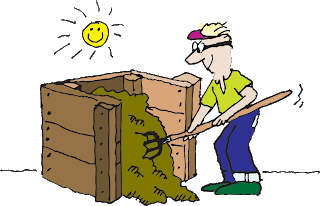We currently live in the basement of a house in Vermont. The lady who owns the house has a compost pile in the backyard. We add to that pile every day! It’s nice for us because we can reduce our amount of waste. There is no garbage pickup in Stowe so we have to take our trash to the dump. It costs $3.50 for two bags.
Why compost?
-Soils and potting mixes that include compost produce healthier plants! It builds good soil structure, enables soil to retain nutrients, protects against drought and protects plants from many diseases.
-It helps the environment by reducing the amount of organic material that goes to waste in your local landfill!
Pick a place for your compost pile
Select a location for composting. The backyard is a great place! You may want to put it near the garden for convenience. Make sure there is good air circulation. Don’t place it next to your house as the decomposing scraps and resulting compost may cause the wood to rot. Partial shade is a good idea so the compost doesn’t get overheated. Also make sure the spot of land where you place your heap gets good drainage.
Create or buy a compost bin
-Collect old pallets. Use one for the bottom. Pound in metal support poles and then add pallets by slipping them over the support poles to make your bin’s walls.
-You can also skip the bin and just have a compost pile or heap.
Size
The perfect size is about 3’ X 3’ X 3’.
Moisture
The microbes that do the work require water for survival. Too much water means your organic waste won’t decompose and you’ll get a slimy and smelly pile. Too little water and you’ll kill the bacteria and you won’t get your compost. The more green material (leaves, grass, weeds) you put in, the less water you’ll need to add.
Aeration
Oxygen is also required by many of the microorganisms responsible for successful composting. Turn the pile often and well. Use a pitch fork, spade, or compost aerator to mix your pile.
Things you can compost
-All fruit and vegetable trimmings
-Coffee grounds and filters
-teabags
-cut up cardboard
All organic matter is broken down initially by naturally occurring microorganisms. To speed up this process kitchen scraps should be cut into small one-inch pieces. After you have added the waste, throw some leaves or grass clippings on top. This will help keep things balanced, reduce smells, and make your compost bin less attractive to critters who are trying to sniff out a free meal.
When is it finished?
Compost is finished when it is a dark, rich color, crumbles easy, and you can’t pick out any of the original ingredients. It can take 3-12 months to create compost. Once you have achieved finished compost, you can add it to the soil any time of the year. Add compost to your garden a few weeks before you plant. An easy way to apply compost is to mulch with it. Spread the compost in a thick layer on top of exposed soil. You can also use compost when potting indoor plants. Use seven parts soil to three parts compost to two parts sand.

No comments:
Post a Comment